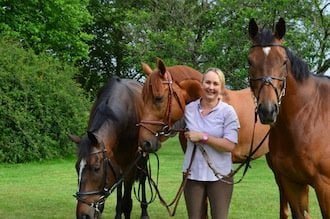Every year thousands of Thoroughbred horses are retired from the racetrack. While every horse is different and some will be more suitable to certain equine pursuits than others, in general Thoroughbreds have even temperaments and are athletic, intelligent and durable. These qualities together with the constant handling they experience during their racing career, means that with the correct retraining, facilities and ongoing care, former racehorses can excel in a wide variety of equine sports. In the first part of our series on reschooling TBs, SA rider Maud Aarts introduced us to 3 young horses transitioning from the track. Here to updates their progress.
Gentle transition

“For the first week that they were off the track I personally dealt with them on the ground, tacking up, taking them to and from the paddock and feeding.” Maud believes that this affords the best opportunity to acquaint herself with new horses and for her to start to understand each personality. “I generally give Thoroughbreds an easy time during the first six months out of racing,” says Maud.
Maud believes Thoroughbreds, as a breed, love to work, so during this time she hacks them out regularly, even if just at the walk, to introduce them to hills, rivers and dams. “This is important to keep everything going,” she says, “and it also helps them find their feet and balance.” In addition Maud believes it aids their straightness, which is key when work is started on the flat.
Strict routine
Life for a horse in training is busy, strenuous and based on a strict routine. Days are governed by regime, with time often being short and horses not accustomed to receiving large amounts of affection. Due to this, Maud finds that “they are almost robotic when first out of racing, as if they are not sure of what is going on.” Maud believes that it takes nearly three months for them to settle in and ‘come to life’. “It’s only then that their personalities come out and you can see what you’ve got,” she smiles.
Physical considerations
For a variety of reasons, including stress, soreness and medications, many Thoroughbreds leave the track with ulcers or poor digestion, Maud believes in treating all Thoroughbreds coming off the track for ulcers.
Thoroughbreds’ backs are very sensitive and as they are started under saddle fairly early in their lives while their bodies are not fully mature, many develop back problems that continue throughout their racing careers. Equine physiotherapists and chiropractors therefore play an integral part in the lives of Maud’s Thoroughbreds, particularly in their first few months off the track.
It is Maud’s practice not to cut a Thoroughbred’s feed dramatically when coming out of racing as it can interfere with their digestive system, she explains. She generally feeds 5 to 6 kilograms of hard feed daily and will only consider reducing the amount when the horse is able to maintain his desired condition.
Look out for more articles in our series on Thoroughbred second careers.
Text & Photography: Michele Wing
This article first appeared in the March 2015 issue of HQ Magazine.

